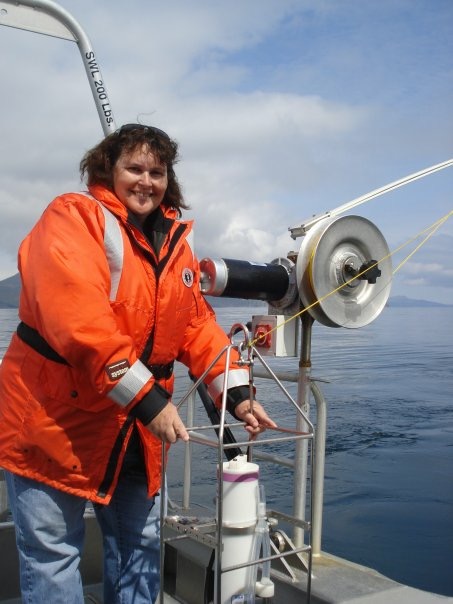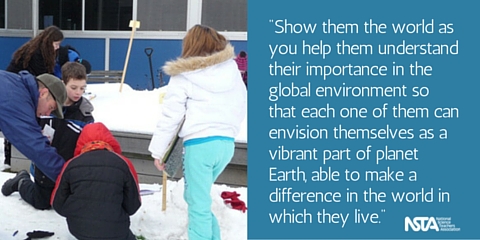Middle School Science Teachers Making a Difference at NSTA
By Guest Blogger
Posted on 2015-11-28
As head of the middle level division at the National Science Teachers Association (NSTA), one of my goals is to communicate more with middle level science teachers. So, we’re launching a blog, which I hope will enable even more grade 5-8 teachers to contribute to and learn from NSTA. The refined focus at this level will provide an additional opportunity for middle level teachers to share ideas and gain insights from their teaching counterparts. I invite all middle level teachers of science to read, share, contribute ideas, ask questions, and otherwise help us create a greater identity in NSTA while enhancing teacher voice at the middle school level.
Who Are We?
I’d like to start by introducing the members of NSTA’s Committee on Middle Level Science Teaching:
- Kenneth L. Huff, Chairperson and Director
- Justin Brosnahan
- Melanie Canaday
- Zoe Evans
- Fran Hess
- John Milam
- Elizabeth Orlandi
- Mary Patterson
- Kitchka Petrova
- Tiauna Washington
- Michael Bowen, District XVIII Director, Council Liaison
- Diana Cost, NMLSTA Affiliate Representative
- Inez Fugate Liftig, Field Editor, Science Scope
Two members serving on the NSTA Committee on Middle Level Science Teaching are featured below.
 Mary Patterson, a 2014-2015 Albert Einstein Distinguished Educator Fellow, 2014-2015 PBS Digital Innovator, and 2009 NOAA Teacher at Sea, has over 30 years of classroom teaching experience at both the elementary and middle school levels. Currently, she is the Campus Content Instructional Specialist for Science, Grades 6 through 8, at Hopper Middle School in Cypress Fairbanks ISD in Cypress, Texas.
Mary Patterson, a 2014-2015 Albert Einstein Distinguished Educator Fellow, 2014-2015 PBS Digital Innovator, and 2009 NOAA Teacher at Sea, has over 30 years of classroom teaching experience at both the elementary and middle school levels. Currently, she is the Campus Content Instructional Specialist for Science, Grades 6 through 8, at Hopper Middle School in Cypress Fairbanks ISD in Cypress, Texas.
For students to become interested in STEM careers, Patterson strongly feels that early career awareness and positive role models are critical. In 2011, a Fund for Teachers grant enabled Patterson to travel to Taiwan and the Carnegie Mellon Robotics Academy to investigate robotics and emerging technological advances. In 2009, Patterson was a National Oceanic and Atmospheric Administration (NOAA) Teacher at Sea. She spent nearly a month on a research ship doing hydrographic surveys in the Pavlov Islands in the Aleutian Island chain in Alaska. In 2006, another Fund for Teacher grant took Patterson half-way around the world to Australia and New Zealand to explore the natural history, ecosystems, and geology of the areas. “Each of these experiences greatly impacted my teaching. I was able to bring back real-world, hands on activities that modeled numerous STEM careers for my students and my students saw me as a scientist. Students said they never knew there were so many different jobs on a ship and now they could see themselves doing science as a career.”
 Fran Hess (a National Board Certified Teacher, past Science Teachers Association of New York State president, former NSTA District IV Director, and Earth Science textbook author) has many years of classroom teaching experience at both the middle and high school levels. Currently, she provides professional development opportunities and mentors teachers across the United States.
Fran Hess (a National Board Certified Teacher, past Science Teachers Association of New York State president, former NSTA District IV Director, and Earth Science textbook author) has many years of classroom teaching experience at both the middle and high school levels. Currently, she provides professional development opportunities and mentors teachers across the United States.
Hess says, “Middle school students, while they can be the most vibrant and challenging, are also the most rewarding students to teach. Teachers need to support and challenge them to strive in the sciences beyond what they may consider are their limits and capabilities. One way teachers can do this is for teachers to take advantages of opportunities to travel, bringing students with them through a variety of mechanisms including through the use of the latest technology, to places they may never have the opportunity to experience otherwise. Show them the world as you help them understand their importance in the global environment so that each one of them can envision themselves as a vibrant part of planet Earth, able to make a difference in the world in which they live.”
Join Us!
If you are a member of NSTA, I invite you to apply to serve on the Committee for Middle Level Science Teaching. Join us as we seek to share and collaborate on promising ideas elevating teacher voice and teacher leadership at the middle level.
To apply to serve on our middle level committee or another NSTA advisory board or panel, please visit: http://www.nsta.org/about/governance/advisoryboards.aspx. The application deadline is December 1, 2015.
Kenneth L. Huff serves on the NSTA Board of Directors as the Division Director for Middle Level Science Teaching. He is a science and math teacher in Williamsville Central School District, Williamsville, New York.
 Get more involved with NSTA! Join today and receive Science Scope, the peer-reviewed journal just for middle school teachers; connect on the middle level science teaching list (members can sign up on the list server); or consider joining your peers for Meet Me in the Middle Day (MMITM) at the National Conference on Science Education in Nashville this spring (sign up to present at MMITM here).
Get more involved with NSTA! Join today and receive Science Scope, the peer-reviewed journal just for middle school teachers; connect on the middle level science teaching list (members can sign up on the list server); or consider joining your peers for Meet Me in the Middle Day (MMITM) at the National Conference on Science Education in Nashville this spring (sign up to present at MMITM here).
Disclaimer: The views expressed in this blog post are those of the author(s) and do not necessarily reflect the official position of the National Science Teaching Association (NSTA).


